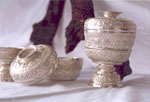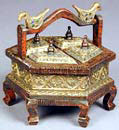|
 Shopping
in Cambodia Shopping
in Cambodia
There
are a wide variety of items available for purchase in Cambodia.
The country was once well-known for its superior silk weaving,
metal work and woodcarving. After decades of neglect, many of
these arts are being revived. Visitors can find silver items,
jewelry, gems, colorful cloth for sarong and hats (variegated
silks), wood carving, paper maché masks, stone copies of
ancient Khmer art, brass and bronze figurines and oil paintings
in the different markets and shops on main avenues. The traditional
clothing for both men and women is the Krama, a long, narrow checked
silk or cotton cloth available in most markets and shops. Jewelry
is generally not up to international standards for design and
workmanship and buyers should use caution when purchasing gold
and gems. The export of antiques is subject to approval of the
Ministry of Culture. Bargaining is essential for all souvenir
shopping, it travelers are to obtain reasonable prices. Reductions
of up to 20 percent are possible.
Encouraged
by the government and aid organisations, local people are rediscovering
their natural talent as weavers and craftsmen.
A number of
rehabilitation programmes have sprung up since the eighties, such
as the gift shop at Wat Thanh in Phnom Penh, a co-op that trains
Cambodians disabled by land mines in making attractive items out
of silk and cotton fabrics, rattan, bamboo, wood and clays. The
result is a pleasing selection of purses and handbags, clothing,
furnishings, paintings and many other items.
Markets -
Designed by a French architect, the bustling art-deco style Central
Market opened in 1937 and is a famous city landmark offering a
wide range of goods, including souvenirs, jewellery, silks, electronic
goods, stationery, second hand clothes, and bric-a-brac. The Russian
Market is good for souvenirs such as objects d'art, trinkets,
coins, miniature Buddhas, etc. The Olympic Market is a three story
covered market near the Olympic Stadium which was upgraded and
reopened in 1994 and now specialises in wholesale items.
Weaving -
Silk in Cambodiais still handmade using traditional methods with
the pattern dyed into the threadsbefore the silk is woven, thus
the task of dying and weaving a single piece can take several
weeks. Older silk pieces (pre-1970) are increasingly prized.Weavers
can be seen in action at the historic silk centre of Koh Dach
outside Phnom Penh. Some nice handiwork comes from Kompong Cham,
Takeo and Kandal provinces.
Silver - Was
prized in the 11th century for religious and ceremonial purposes.
With tourism expanding, numerous silver shops have sprung up in
Phnom Penh, selling carved decorative and practical items. Other
outlets are in village centres such as Tul Mau, roughly 30 km
north of the city. The normal working material is an alloy containing
70-80 percent of pure silver, and prices are based on a combination
of weight and artistry, which puts bargaining skills to a good
test.
Basket weaving
- Carried out mainly by women, many of whom cultivate and harvest
the reeds by themselves. It is also an important aspect of rehabilitation
programmes for victims of landmines and the dexterity of the local
people is beautifully reflected in products of all kinds, including
baskets, bowls, plates, and many other useful items. 
Antiques -
The sale and export of registered antique pieces is strictly forbidden.
This, alas, has not prevented thousands ofpriceless artifacts
from Angkor being stolen over the years, and sold overseas. You
are however unlikely to come across genuine antiques openly on
sale in Cambodia
Sculptured
Reproductions - There are excellent reproductions and copies available
at reasonable prices. The intrinsic skill of craftsmen - using
the same locally mined stone used to build the ancienttemples
- produces sculptures of such quality that, with artificially
induced weathering, have even fooled some experts. There are also
bronze copies of small statues, Buddha figures, heads and apsaras
forsale. These can be exported freely, but if you pass through
Thailand on the way home, remember that the export of Buddha figures
from that country is not allowed.
Wood Carving
- A traditional, if sometimes hefty, addition to your baggage
allowance are carved wooden apsaras, and a variety of other attractive
and decorative wooden items, including furniture, which can be
shipped home. Since the quality and maturity of the wood dictates
its value as much as the handiwork, care in selection is needed,
especially for more expensive items, and it pays to shop around.
Custom Made
Tailoring - Following the lead of Bangkok's ubiquitous and often
over-persuasive purveyors of made-to-measure clothes, ready in
a day or even less, there are now many tailor shops opening in
Phnom Penh. Tailors will happily copy from a photo or from a sample
in your suitcase.
Betel nut
boxes - These cute containers once reflected the status of their
user according to its size, design and the material from which
it was made . Mostly of silver, many carry ornate designs, and
are often crafted into animal shapes. Originals usually contain
a higher quantity of silver, but the newly manufactured varieties
are still handmade, and a careful choice can provide you with
attractive souvenirs or thoughtful lightweight gifts.
Gold and Gems
- 24-carat gold is used for most pieces in the Chinese tradition
with prices fluctuating with the daily market value. Jewellery
tends to be simple and unsophisticated, and although locally mined
precious stones - especially rubies, sapphires and emeralds -
can make excellent buys, beware of increasing numbers of fakes.
Lacquerware
- Most pieces originate in Vietnam, or are made locally by expatriate
Vietnamese craftsmen. Local markets normally have a good supply,
and the prices are often more competitive (with suitable bargaining)
than in the markets of Vietnam.
Rice paper
prints ("Temple Rubbings") - A lightweight, decorative,
inexpensive and attractive buy, made by placing rice paper over
a mould taken from a bas-relief carving from one of the Angkor
temples and lightly rubbing over it with soft charcoal. When framed
and suitably illuminated, they can look superb. 
Cotton T-shirts
- Some very cheap and amusing designs are available, which make
excellent small gifts or souvenirs.
The Krama
- The typical locally worn chequered scarf. Uniquely Khmer, inexpensive,
and practical.
 Top Top
|